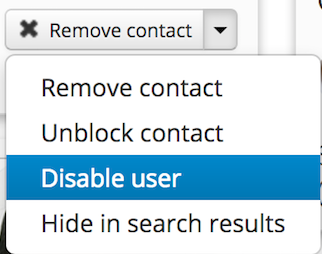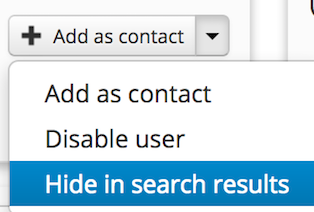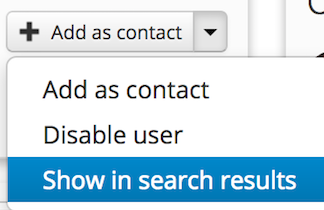help.sitevision.se always refers to the latest version of Sitevision
Manage social identites
The Contact status module is used on the profile page to manage the contact relationship between users. The module is only visible if you visit another user's profile page. It is not visible on your own profile page.
With the Contact status module, you can manage social user identities if you have permission. You can disable/enable the user identity and choose whether to show or hide it in search results. This is a function that you can use if an employee for example is on leave or sick. If you need to completely remove a social user identity, you need to move the user out of the search base in the directory service instead.
Read more about Removing a user identity by moving it out of the search base.
This function requires you to have "Manage users" permission
Consequences of disabling a user identity
When a user identity is disabled, links from timelines and Social Collaboration comments will be deselected as links. This means that it is not possible for users to visit the disabled user identity profile page via, for example, posts that belong to the disabled user identity.
Disabled user identities will not be listed as contacts and/or followers on profile pages. Also, user identities will not appear as members or administrators in groups.
When a user identity is disabled, you will no longer be able to search for it in search modules associated with Social Collaboration. Disabling removes the user identity from the search index and thus also from the search results.
Although a user identity is disabled, it will be possible to access the user's profile page via a direct link. Direct links can appear as bookmarks in web browsers or as links on different pages.
Consequences of hiding a user identity
Hiding a user identity causes it to be removed from the user index, where user identity information is saved. Thus, it will not be possible to search for the user via various search modules linked to Social Collaboration.
Although a user identity is hidden in the search results, it will be possible to access the user's profile page via a direct link. Direct links can appear as bookmarks in web browsers or as links on different pages.
Follow these steps
Disable user
1. Go to the profile page for the user identity/user you want to disable.
2. Click on the arrow on the right of the "Remove as Contact" button. You will see a submenu with four options.
3. Click on "Disable user".

Enable user
1. Go to a page where the Search user module is available.
2. Search for the user's name in the search box. If you have permission to manage social user identities, you see the Search for inactive or hidden users checkbox.

3. Tick the “Search for inactive or hidden users” checkbox. Click on the user you want to activate. You will be sent to the User's profile page.
4. Click on "Enable user".

Hide in search results
1. Go to the profile page of the user identity/user you want to hide in SiteVision’s search index and thus in the search results.
2. Click on the arrow on the right of the "Add as Contact" button. You will see a submenu with four options.
3. Click on “Hide in search results”.

Show in search results
1. Go to a page where the Search user module is available.
2. Search for the user's name in the search box. If you have permission to manage social user identities, you see the Search for inactive or hidden users checkbox.

3. Tick the “Search for inactive or hidden users” checkbox. Click on the user you want to activate. You will be sent to the User's profile page.
4. Click on “Show in search results”.

The page published:

 Print page
Print page